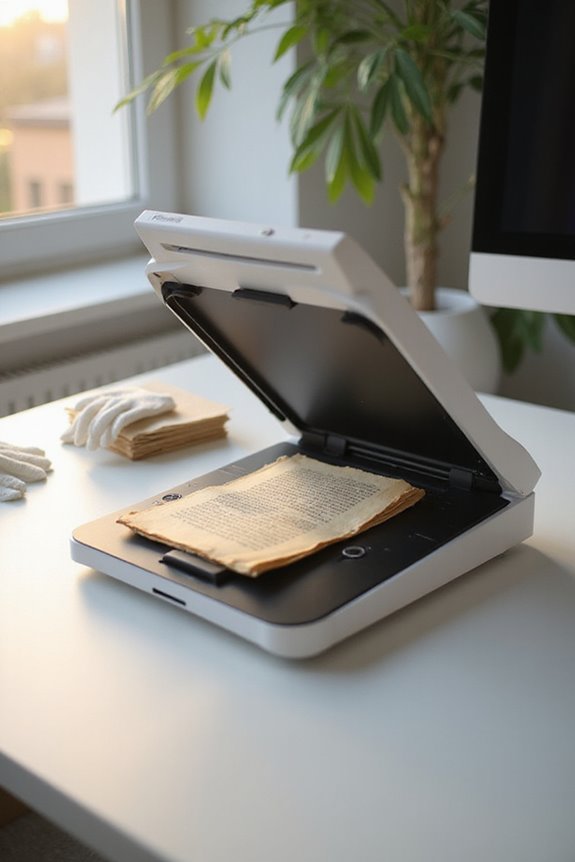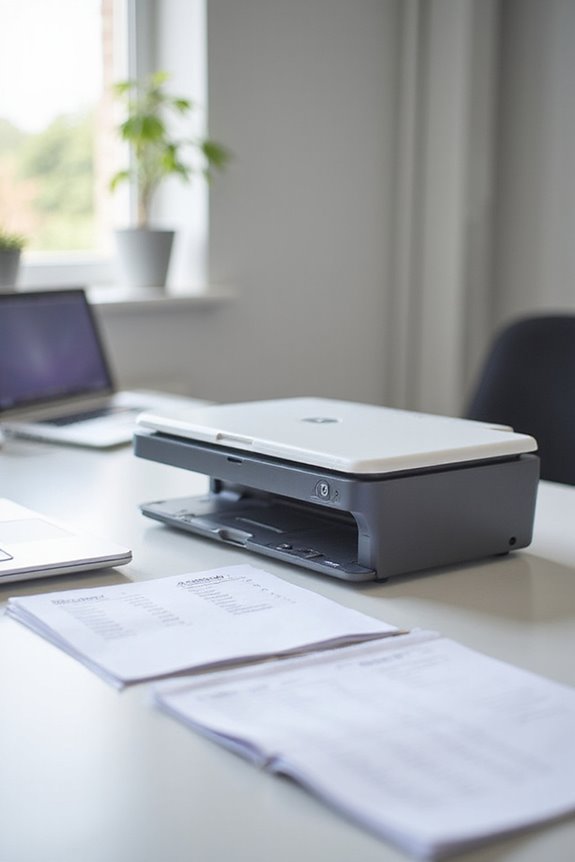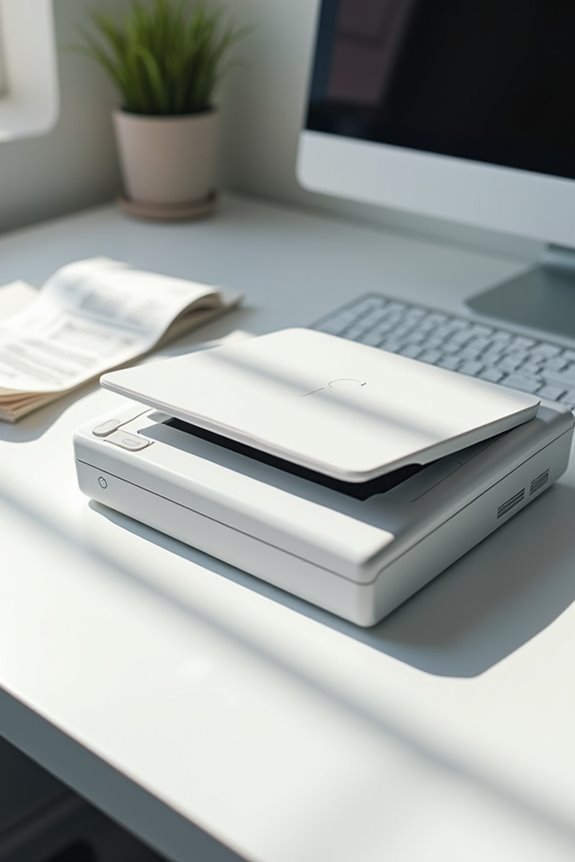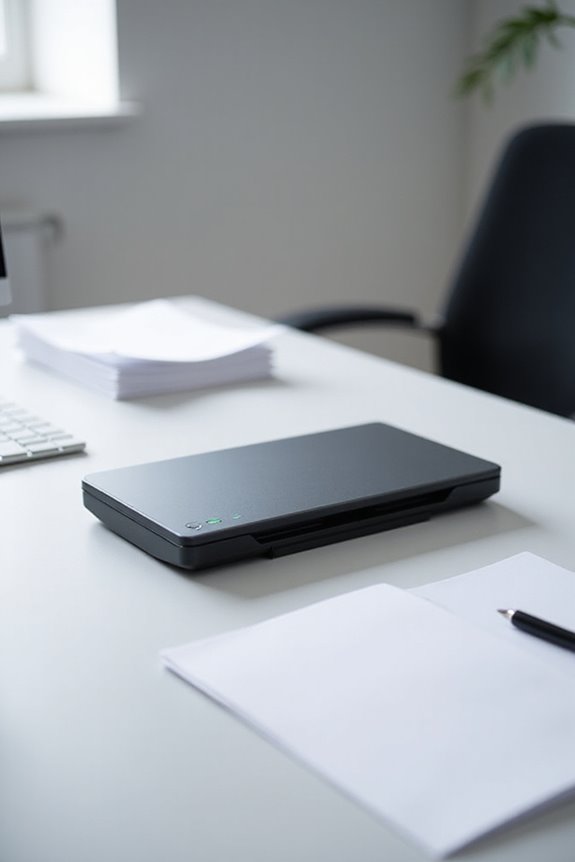To scan fragile or old documents, we first assess their condition, checking for tears or discoloration. Next, we clean them using a soft brush to avoid damage. Choosing a flatbed scanner guarantees minimal risk with delicate items, aiming for a resolution of at least 300 DPI. During the scanning process, we support fragile pages with book cradles. This approach maintains their integrity and enhances clarity. Continue with us to explore storage options for your digital files.
Key Takeaways
- Assess the document’s condition for any damage before scanning and conduct necessary repairs to ensure integrity.
- Clean the surface using soft brushes to remove dust while handling the document by its edges to avoid smudging.
- Use flatbed scanners for delicate documents, ensuring a resolution of at least 300 DPI for quality preservation.
- Support fragile items with book cradles during scanning to reduce exposure to light, heat, and potential damage.
- Flatten rolled documents using controlled humidification techniques to maintain structure and avoid misfeeds during scanning.
Assessing Document Condition
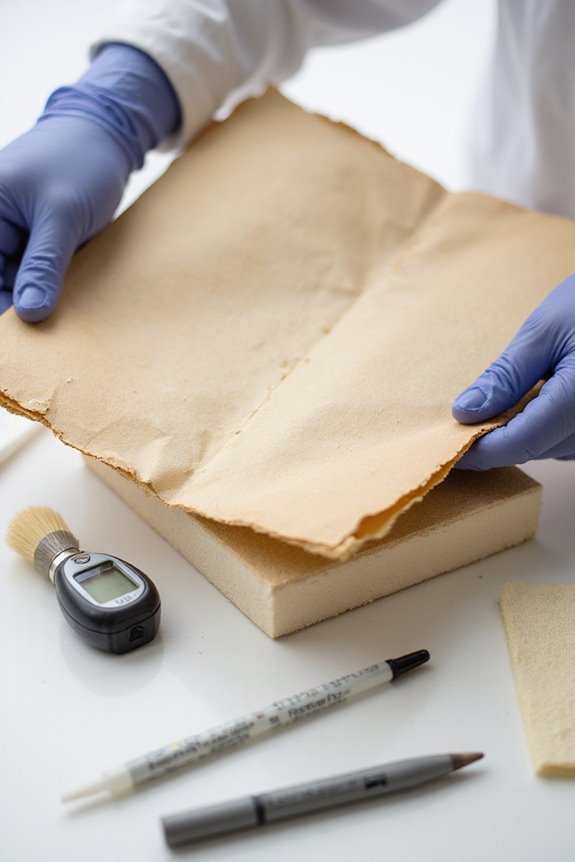
When it comes to evaluating document condition, we should start by closely examining the physical state of the item. Our condition evaluation process begins with visual inspection, looking for visible damage like tears, creases, or discoloration. We check for signs of foxing, which appears as brown spots and yellowing that indicate age. Additionally, we assess the binding to guarantee pages are secure, and we remain alert for potential pest damage such as small holes or trails. While conducting damage assessments, we must document our findings meticulously, using high-resolution photography and standardized ratings. This thorough approach allows us to track deterioration over time, guiding future decisions for conservation and guaranteeing these important materials remain safe and accessible. Utilizing scanners with high-resolution capabilities can further enhance the clarity of documentation during the assessment process.
Cleaning and Preparation Techniques
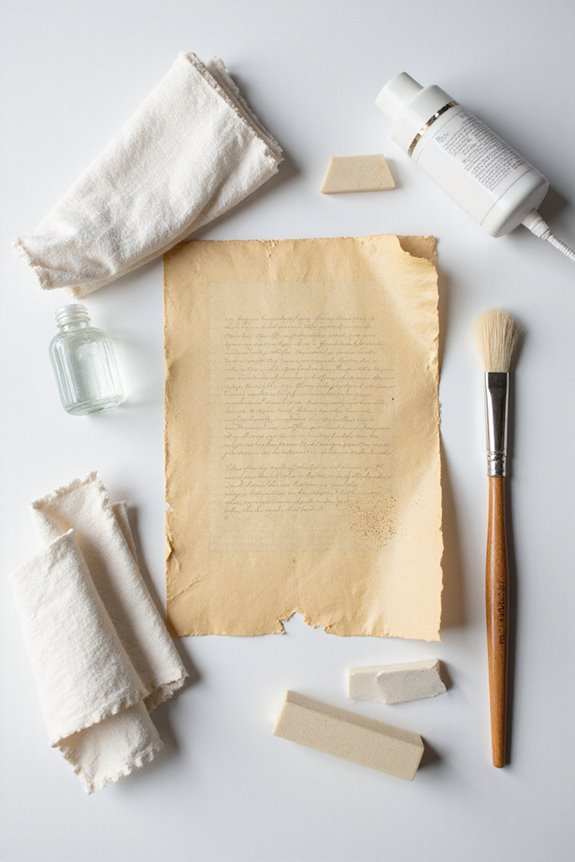
Cleaning and preparation techniques are crucial for preserving fragile or old documents before scanning. We should always wash and dry our hands before handling to avoid transferring oils. Utilizing proper handling techniques, like holding pages by their edges, minimizes smudging. We can start our cleaning with suitable cleaning tools, like a soft brush or a lint-free cloth, ensuring we sweep away dust gently. It’s essential to avoid any liquid cleaners, as these can damage the delicate paper. For any loose particles, a controlled burst of compressed air provides a safe solution. Disposing of staples and sticky notes beforehand prevents additional damage, while grouping similar-sized papers helps streamline our cleaning process for efficiency. Additionally, digitizing legal documents can enhance the longevity of fragile materials by creating backup copies that can be easily accessed without further wear.
Flattening and Repair Methods
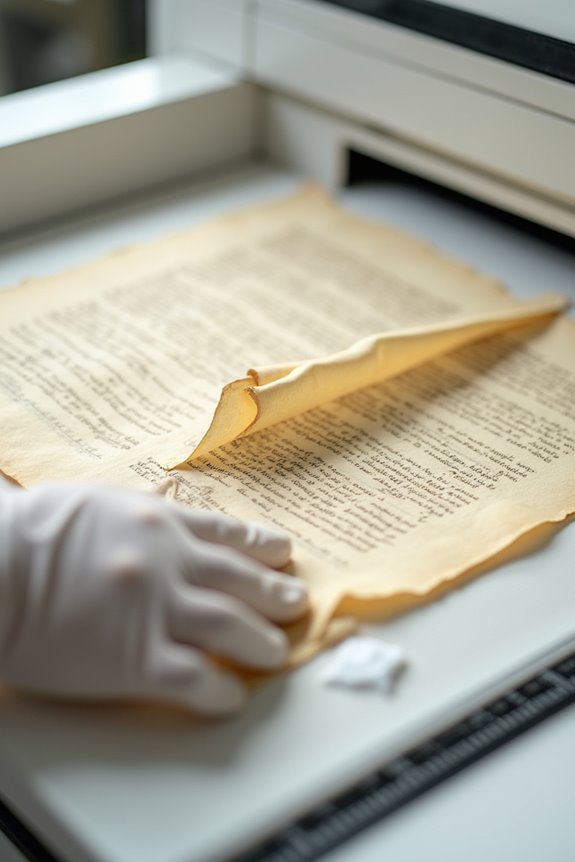
To effectively preserve fragile or old documents, we can employ various flattening and repair methods that enhance their longevity. One effective approach includes using the Face-to-Face Taut Screens method, which supports wet papers with polyester web sandwiches. This minimizes distortions, especially in handmade papers. After air drying, we can utilize humidification and weight to achieve original dimensions, enhancing both texture and planarity. Controlled humidification in blotters allows moisture absorption, with multiple layers aiding in even drying. We might also opt for flattening under tension, carefully applying force to address areas with different dimensional stabilities. Each flattening method we choose can considerably enhance the document’s usability and integrity, ensuring it’s well-preserved for future generations. Additionally, utilizing high-resolution scans allows for detailed digital preservation of these documents, ensuring their content is not lost over time.
Selecting the Right Equipment
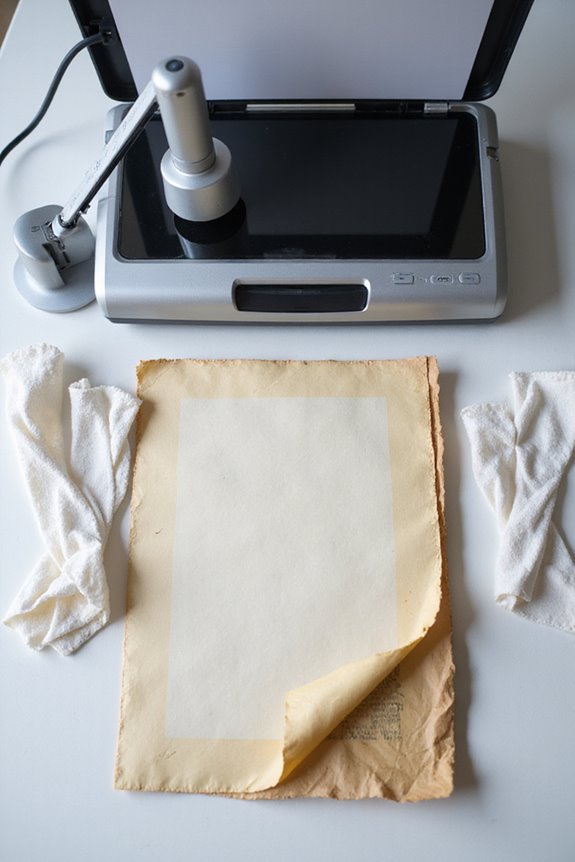
Selecting the right equipment for scanning fragile or old documents is essential, as it directly impacts the preservation of these valuable items. We should consider flatbed scanners for larger documents, as their flat surfaces minimize the risk of damage. Compact portable scanners are great for on-site needs, but they often struggle with fragile items. We also find ultrasonic double feed detection scanners helpful, as they prevent misfeeds. When comparing brands, Canon offers reliable versatility, while Epson excels with robust ADF capabilities. Fujitsu models, like the fi-6230Z, provide excellent performance for archival projects. Remember to look for scanner features like high-quality sensors and adjustable scanning speeds to capture fine details accurately. Additionally, choosing models with advanced paper handling technology helps minimize rescans and preserves the integrity of delicate documents. Choosing wisely helps preserve history for future generations.
Scanning Techniques for Preservation
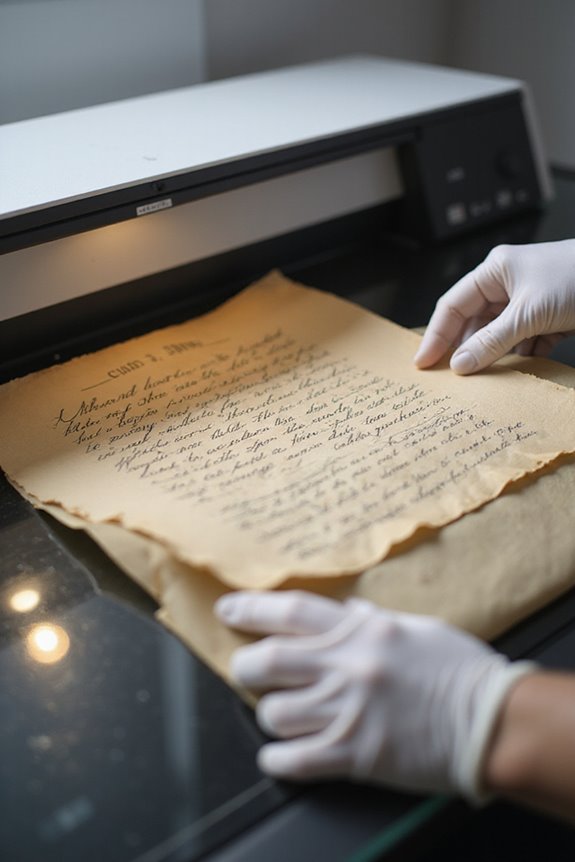
When it comes to scanning fragile or old documents, proper techniques can make all the difference in preserving their integrity. We start by evaluating the document’s condition, identifying any tears or folds that may require attention. Cleaning is essential, so we use soft brushes to remove dust. For rolled documents, flattening them in a humidity-controlled environment helps maintain their structure. Using advanced scanning methods, we choose flatbed or overhead scanners based on document needs, guaranteeing a resolution of at least 300 DPI for quality. During scanning, we support fragile documents with book cradles, minimizing exposure to light and heat. These preservation best practices guarantee we capture each document’s details while safeguarding against future deterioration. Additionally, opting for a scanner with high optical resolution ensures that even the finest details are accurately captured.
Storing and Preserving Digital Files
As we contemplate the importance of storing and preserving digital files, it’s essential to have a structured approach in place. First, we should establish standardized naming conventions and hierarchical folder structures, guaranteeing easy retrieval of documents. Implementing backup strategies is critical too—creating multiple copies stored in different locations guards against loss. Utilizing formats like TIFF or PDF/A enhances longevity and accessibility, avoiding obsolescence. Regular audits can help us identify misfiled or duplicated files, while logs track modifications and access to maintain transparency. Additionally, version control systems allow us to preserve multiple iterations of files, safeguarding against unwanted changes. Following these steps guarantees our digital archives remain organized, secure, and accessible for years to come. Furthermore, incorporating OCR technology into the archiving process can significantly enhance document searchability and management.
Regular Maintenance of Digital Archives
Regular maintenance of digital archives is vital for guaranteeing they remain functional and user-friendly. To achieve effective digital archiving, we must define clear objectives and assign responsibilities. Regularly reviewing our archives guarantees we keep everything current and relevant.
We should implement consistent naming conventions and intuitive folder structures, making file retrieval easy. Training users on these systems fosters consistency in uploads and edits. Regular audits are also essential, as they help us check the integrity of files and verify compliance with retention policies.
Establishing retention and disposal policies further aids in managing clutter. By monitoring our archives and providing thorough training, we enhance overall accessibility and promote efficient archive maintenance that meets our organizational goals.
Frequently Asked Questions
How Can I Tell if My Document Is Too Fragile to Scan?
Oh joy, the thrill of document assessment! If it’s cracked, brittle, or looks like it survived a war, it’s likely too fragile for current scanning techniques. Let’s handle it like a Fabergé egg, shall we?
What Temperature and Humidity Levels Are Ideal for Document Preservation?
To guarantee our documents’ longevity, we should maintain ideal conditions: temperatures between 18° to 22° C and humidity levels of 40% to 55%. These preservation techniques help protect our collections from mold and brittleness.
How Often Should I Check the Condition of Stored Documents?
Isn’t it essential to guarantee our documents remain intact? We should practice regular document maintenance; ideally, we check their condition every 3 to 5 years, guaranteeing proper preservation frequency to protect valuable information for the future.
Are There Any Tools Specifically Designed for Assessing Document Fragility?
We’ve found that fragility assessment tools focus on non-destructive methods and preservation techniques, helping us evaluate documents’ condition while minimizing damage. Specialized scanners and environmental monitors aid in preserving fragile materials effectively for future generations.
What Should I Do if I Find Mold on a Document?
If we find mold on a document, we must prioritize mold removal and preservation. Let’s isolate the item, dry it carefully, and consider professional help to guarantee proper document preservation without further damage.

